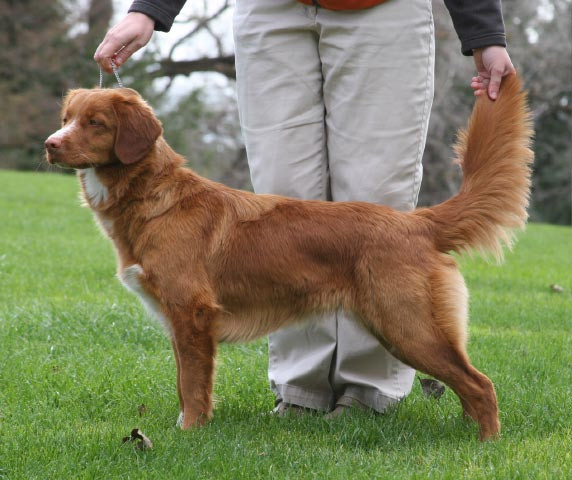Nova Scotia Duck Tolling Retriever Dog Breed
The Nova Scotia Duck Tolling Retriever, also known as the Toller, is a breed that has captured the hearts of many with its hunting skills and friendly nature. Originating in the early 1800s in Nova Scotia, Canada, this dog is renowned for its unique tolling method used to attract waterfowl for hunters.
Featuring a muscular build, striking red coat, and white accents, Tollers are attractive but also intelligent and amiable. However, they need plenty of exercise and mental stimulation to be happy.
When considering this breed, looking at their history, health concerns, and daily care is crucial. Potential owners must weigh these factors against the Tollers’ engaging personality and versatility.
Key Takeaways
- Nova Scotia Duck Tolling Retrievers excel in luring ducks.
- Exercise and mental stimulation keep Tollers content.
- Research health and care before getting a Toller.
Quick Facts
The Nova Scotia Duck Tolling Retriever stands out in the Sporting Group for its unique red coat. Known for being intelligent and flexible, these dogs often live around 12-14 years. Males typically reach 18-21 inches tall and weigh in at 35-50 pounds, while females are a tad shorter at 17-20 inches but also range in weight from 35-50 pounds. Their striking coat is easy to care for despite a tendency to shed heavily sometimes. They love water and might get messy, so they’ll need a good grooming routine.
These dogs are quick learners and ready to please, making training a breeze. They need mentally stimulating tasks to keep them from getting bored and acting out. Tollers are excellent at retrieving game from chilly waters and keeping an eye on their home without being too noisy. They aren’t cut out for guard duty, as they’re not particularly protective and can be a bit shy. They’re loving and lively, great with families and children, but might take a moment to warm up to new faces. It’s critical to start training and socialization early to help them develop a balanced temperament.
Nova Scotia Duck Tolling Retriever Dog Breed Pictures






Overview
Hailing from the scenic landscapes of Canada, the Nova Scotia Duck Tolling Retriever is a medium-sized dog breed noted for its striking red coat and superior hunting skills. Known for their intelligence, agility, and willingness to learn, these retrievers excel in fetching games and hunting scenarios. Their coat is easy to care for, requiring routine brushing to keep it shiny.
These dogs typically live 12 to 14 years and are pretty robust, but like all breeds, they benefit from regular vet visits to head off any potential health concerns. Nova Scotia Duck Tolling Retrievers adapt well to different homes, from spacious houses to smaller apartments, as long as they exercise enough. They thrive on vigorous daily activity, enjoying a mix of physical and mental challenges, like swimming and advanced fetching tasks.
Socializing them early is critical to ensuring a friendly and well-mannered pet. They are well-suited for people and families who love the outdoors, as these dogs love rugged weather conditions.
Breed’s Key Traits

Nova Scotia Duck Tolling Retrievers, often known as Tollers, are medium-sized dogs standing about 17 to 21 inches tall and weighing between 35 and 50 pounds. They are known for their distinctive red and white coats, which require regular maintenance to keep them in good condition.
These dogs are intelligent and energetic and strongly desire to make their owners happy, making them excellent family pets. They require a lot of exercise and mental challenges to stay content and out of trouble. Tollers are generally healthy, but they can be susceptible to specific health issues like hip dysplasia, progressive retinal atrophy (PRA), and autoimmune thyroiditis, so it’s vital to get them from breeders who conduct thorough health screenings.
Tollers excel in canine sports due to their high intelligence and stamina. Their love for water and innate retrieving abilities also make them top-notch hunters. When integrated into a family, they form strong bonds and can be very affectionate. They get along well with children and other pets, especially when properly socialized from a young age.
To maintain their well-being, watching for common genetic health conditions is critical. Always choose respected breeders who provide detailed health clearances for their dogs.
History of the Nova Scotia in the Early 19th Century

The Nova Scotia Duck Tolling Retriever, known affectionately as the Toller originated in the early 1800s in Nova Scotia. This dog was expertly bred to both attract and retrieve waterfowl for hunters. The breed’s evolution gives us insight into its past roles and the genetics that shaped its behavior.
Selective breeding honed the Toller’s skills for enticing ducks within shooting range and fetching them after being shot. This process has resulted in a dog with exceptional abilities in the field. The bond between early Tollers and their owners was strong, forged through countless hours of working together in the rugged Canadian outdoors.
These dogs are a living piece of Canada’s hunting heritage and are admired for their historical significance. Tollers have an infectious enthusiasm when working, making them beloved by boaters and those looking for an energetic family pet.
Breed Development Timeline
In the 1800s, the coastal town of Little River Harbour in Nova Scotia witnessed the origin of the Nova Scotia Duck Tolling Retriever, originally known as the Little River Duck Dog. This breed emerged through careful crossbreeding of retrievers, spaniels, setters, and a farm collie mix to perfect its hunting abilities.
Recognized in 1945 by the AKC as a purebred, this dog had established its exceptional traits and effectiveness in hunting. By 1980, it gained national recognition and was honored as Nova Scotia’s provincial dog in 1995. Thanks to its double coat that repels water, it celebrated the breed’s deep roots in Canadian culture and its adeptness in waterfowl hunting.
Hunting Companion Roots
In the early 1800s, hunters often had the company of Nova Scotia Duck Tolling Retrievers, or what used to be called Little River Duck Dogs. Bred in Little River Harbour, these dogs were skilled in luring and fetching waterfowl for the hunters. Their playful antics near the water’s edge were not just for fun; it was a strategic act known as ‘tolling’ to bring ducks within range.
The ancestry of these retrievers is quite varied, with genes from other retrievers, spaniels, setters, and a type of farm collie mix. This diverse heritage gave them their hunting prowess. Physical traits like a water-repellent double coat, a robust body, and webbed feet made them ideal for the job. They need plenty of exercise and mental stimulation to satisfy them.
Distinctive Toller Traits
Nova Scotia Duck Tolling Retrievers, often called Tollers, have a rich history as hunting dogs, perfected over time since their origin in the 1800s near Little River Harbour. These dogs excelled at a hunting technique known as tolling, which involves enticing ducks closer by playing and frolicking along the shoreline. Tollers have a strong instinct to chase prey, which makes them excellent at bringing ducks close enough for hunters to shoot.
The Canadian Kennel Club recognized Tollers as an official breed in 1945. These dogs are medium-sized and are known for their beautiful red and white coats, with a distinctive white-tipped tail — a feature that sets them apart as the smallest in the retriever family. They are intelligent and full of energy, which means they thrive on plenty of physical activity and mental stimulation. This is a nod to their breeding, which aimed to develop a dog with endurance and the ability to move swiftly in chilly waters.
Medium-Sized Build

The Nova Scotia Duck Tolling Retriever’s medium-sized structure is perfect for its role as an active sporting dog. This breed combines a weight that supports stamina and speed, making it big and agile. Their proportionate build not only aids in their job as working dogs but also adds to their visual charm.
These dogs carry themselves with grace, making them stand out. Their robust build reflects their lively spirit, showing they are ready for any activity. These retrievers are stolid and elegant, capturing what it means to be an adaptable pet. They are resilient, always up for an exciting day out or have a relaxing time by your side.
Ideal Toller Dimensions
The Nova Scotia Duck Tolling Retriever, affectionately known as the Toller, is a breed loved for its charming looks and versatile abilities. A full-grown male Toller stands 18 to 21 inches at the shoulder, while the female usually reaches 20 inches. This breed is designed to be medium-sized and is muscular enough for its retriever duties, with males tipping the scales at 35 to 50 pounds and females weighing slightly less.
Tollers flaunt an athletic frame that suits them for various environments, from the spacious countryside to the compact city life. Keeping a Toller in top shape involves feeding them a diet rich in nutrients, ensuring they have plenty of water, and regularly checking their physical condition. This care helps them fulfill their role as eager and enduring working dogs.
Weight and Height Range
Knowing the size of the Nova Scotia Duck Tolling Retriever helps to understand their medium build. Males usually measure 17 to 21 inches tall, and females range from 17 to 20 inches. They weigh between 35 and 50 pounds, fitting them into the medium category of dogs as per the American Kennel Club’s Sporting Group. These retrievers have a life expectancy of about 12 to 14 years.
Keeping them at a healthy weight is crucial to their well-being. Owners should ensure the dogs get enough exercise daily. A balanced diet and regular exercise are essential to keep these active dogs in good shape for their entire lives.
Proportionate Physique Traits
Nova Scotia Duck Tolling Retrievers are medium-sized dogs known for their well-balanced and athletic bodies. They have a deep chest, strong legs, and webbed feet w, making them highly agile and versatile for various physical tasks. Male Tollers typically stand between 18 and 2 inches tall, while females range from 17 to 2 inches. Weight-wise, they fall between 35-50 pounds, reflecting their muscular yet compact build that supports both stamina and power.
Their coat, a striking red with white accents, is of medium length and has a double layer, needing regular care to stay in good shape and to keep shedding under control. With these proportionate features, Tollers are well-suited for different living spaces and shine in active pursuits like field sports, agility competitions, and obedience events.
Athletic Build Benefits
Nova Scotia Duck Tolling Retrievers are known for their athleticism, which serves them well in busy life and outdoor adventures. Their strength, agility, and endurance make them stars in dog sports, excelling in quality, dock diving, and obedience.
These medium-sized dogs fit well in various homes as long as they get plenty of exercise and have mental challenges to keep them from getting bored and acting out.
Their love for water and active play perfectly match their body’s abilities, keeping them physically and mentally sharp. Regular engaging activities are critical to their well-being, ensuring they stay happy and healthy.
Comparison With Similar Breeds
In comparing the Nova Scotia Duck Tolling Retriever to other medium-sized dogs, its bright red fur and all-around athleticism are pretty noticeable. This is especially true when you look at the different sizes and personalities of Labradors, Golden Retrievers, and similar breeds.
Smaller than a Chesapeake Bay Retriever but more significant than a Boykin Spaniel, the Toller brings much energy. Its red fur also contrasts the Curly-Coated Retriever’s unique curls and the Irish Water Spaniel’s distinctive rat tail.
Though Tollers might remind some people of a more miniature Golden Retriever because they’re both friendly and close in size, the Toller’s quickness and sharp senses set it apart from the Golden’s more relaxed and tolerant nature.
Intelligent and Outgoing Nature

The Nova Scotia Duck Tolling Retriever shines with its quick-witted and friendly spirit. This breed excels in learning new things and craves regular interaction with people. Tollers have a knack for tackling challenges and quickly to new training techniques that suit their keen minds and energetic bodies. They bring fun to every activity, highlighting the need for tasks that keep them mentally sharp and physically active.
Teaching a Toller is a rewarding experience as they are always ready to learn and connect with their trainers. Their boundless energy breathes life into every game, showing their warm nature and zest. These dogs create deep connections with others, revealing their intrinsic need for friendship. Their knack for figuring things out indicates the breed’s intelligence and ingenuity.
It keeps dogs busy with activities that engage their brains and tap into their natural talents. It is essential to witness their playful spirit, which reminds us of the joy pets bring into our lives. When Tollers are part of a family, they become dedicated companions, showcasing their strong social ties. Their ability to solve problems impresses anyone who sees them in action, proving that they are not just pets but also intelligent, capable friends.
Toller Learning Capabilities
Nova Scotia Duck Tolling Retrievers are known for their intelligence and quick learning skills, which make them excellent at acquiring new abilities. These dogs are eager learners and respond well to obedience training, primarily handled with patience and kindness due to their sensitivity.
To make the most of a Toller’s potential, it’s crucial to provide clear and consistent guidelines to keep them from becoming bored and acting out.
These friendly dogs form strong connections with their owners, which can boost their eagerness to learn during training. To keep Toller engaged and prevent them from becoming too controlling, they need challenging and exciting tasks. Their natural inclination to work and fetch means they thrive on plenty of physical activity and brain games to stay healthy and happy.
Engaging Playfulness
Nova Scotia Duck Tolling Retrievers are known for their intelligence and zest for life, displaying a kind of playfulness that makes them great pets and responsive learners. These dogs thrive on interactive and brain-teasing games, making the most of their desire to please during training. Tollers pick up new skills quickly, which makes positive reinforcement work well for them, creating a rewarding experience for both the dog and the person training them.
They’re outgoing and full of spirit but so sensitive, so it’s essential to use gentle training methods. This approach helps to create a positive learning space. The breed’s natural cheerfulness and ability to communicate are vital to their charming personality, and they help strengthen the bond between dogs and their owners.
Social Interaction Needs
Due to their intelligent and outgoing nature, va Scotia Duck Tolling Retrievers thrive on interaction with their human families. These dogs love to be around people and respond well to human attention. Their friendly nature makes them great with kids, but adults must oversee these interactions and teach children how to interact with dogs respectfully.
Tollers do best when they have clear rules and are trained with kindness and an understanding of their sensitive nature. They are expressive dogs who need owners who understand and respond to their social cues. A well-socialized Toller is generally a happy Toller, as this helps stave off behaviors that stem from boredom or anxiety.
Activities involving environmental and physical engagement are essential for these loving, family-centered pets.
Problem-Solving Skills
Nova Scotia Duck Tolling Retrievers showcase impressive problem-solving skills due to their sharp minds and friendly nature. These qualities are crucial for complex training routines and adapting to new situations. They pick up new tasks swiftly, showing their mental prowess. Tollers are sociable and aim to please, which makes training not just efficient but enjoyable too. They do well in various dog sports because they find them stimulating.
To keep their minds active and prevent unwanted behaviors, it gives dogs tasks that challenge them. They must be emotionally sensitive, so they benefit most from the patient and responsive training. When trained with care, they become even better at solving problems.
Adaptability in Training
Nova Scotia Duck Tolling Retrievers are known for their problem-solving abilities and adapt well to training due to their intelligent and friendly personalities. They learn quickly when they have a strong relationship with their trainer, but it’s essential to apply rules consistently to prevent them from becoming too clever for their own good.
This breed loves to be active, and they shine in dog sports, which keeps their minds engaged and helps prevent destructive behaviors such as boredom.
When training Tollers, it’s vital to remember their sensitive nature and use firm but kind methods. Applying the correct pressure keeps them focused and moving forward in their training.
With the right approach, these dogs stay sharp and eager to please, making the most of their intelligent and friendly traits.
Scotia Duck Tolling Retriever Health Concerns
Nova Scotia Duck Tolling Retrievers are generally healthy, but like all breeds, they have their share of genetic health issues. These dogs can suffer from hip dysplasia, a condition where the hip joint doesn’t fit together perfectly, leading to arthritis and discomfort. They can also develop progressive retinal atrophy, which can cause blindness. Regular vet check-ups can catch these problems early, improving the dog’s quality of life.
Responsible breeding and proper medical care are crucial for these dogs’ well-being. A Toller in pain from hip dysplasia might have trouble walking or playing. Losing vision from progressive retinal atrophy can be scary for a dog, as it doesn’t understand why it’s happening. Conditions like autoimmune thyroiditis, which affects hormone production, can leave a dog feeling constantly out of sorts. Also, Addison’s disease can strike without warning, leading to serious health problems.
Responsible breeders should screen for these conditions to ensure the healthiest puppies possible. Dog owners should be vigilant and proactive with their pet’s health by scheduling regular vet visits. Early detection and treatment can make a big difference in managing these genetic conditions.
Inherited Diseases Prevalence
Nova Scotia Duck Tolling Retrievers are generally healthy dogs with a higher risk for certain genetic conditions. Hip dysplasia is expected. It’s a hip joint malformation that can cause arthritis and difficulty walking. Eye disorders like progressive retinal atrophy and Collie Eye Anomaly are also concerns and can lead to vision loss or blindness.
These dogs can suffer from immune system problems, including rheumatic diseases and Addison’s disease. The Finnish breed club specifically points out immune health as a critical issue. These dogs must undergo regular health checks, including screening for thyroid and eye conditions. Responsible breeders will offer health clearances to help prevent these hereditary diseases.
Most Tollers live healthy lives, but it’s worth noting that cancer is a leading cause of death in the breed.
Regular Health Screening
Regular health checks are essential for Nova Scotia Duck Tolling Retrievers to catch and manage inherited health issues. These exams are levitator spotting early symptoms of progressive retinal atrophy (PRA), an eye disease that can cause blindness. Tests for Addison’s disease are also necessary to identify this hormonal imbalance early on.
A vet’s thorough check-up can pick up on signs or markers of these diseases. Since autoimmune thyroiditis is another concern for this breed, checking thyroid function should be a part of routine health care.
Consistent vet visits help manage these genetic conditions and keep your Nova Scotia Duck Tolling Retriever healthy.
Managing Genetic Disorders
Ensuring the health of Nova Scotia Duck Tolling Retrievers involves proactive steps by breeders to test for genetic conditions.
Genetic screening helps pinpoint potential carriers of disorders, guiding breeding choices to reduce the risk of these conditions in puppies. Partnering with a responsible breeder is critical as they should have completed health exams on the puppy’s parents and provide proof of their genetic status.
It’s also vital for owners to stay on top of their dog’s health with regular vet visits to catch any early signs of hereditary problems.
Understanding the specific health risks for this breed allows owners to spot early symptoms and seek treatment swiftly.
A nutritious diet and regular exercise are essential for your dog’s overall well-being and can help lessen the effects of genetic disorders.
Train Your Dog and Grooming Requirements
Maintaining the health and appearance of the Nova Scotia Duck Tolling Retriever’s coat requires regular care. Knowing the specific needs of their coat type is necessary to determine how often to brush, which helps prevent mats and spreads the dog’s skin oils. Scheduling baths and maintaining nail and ear keys for the dog’s hygiene and comfort.
Regular grooming ensures the Nova Scotia Duck Tolling Retriever’s coat stays shiny and helps minimize the presence of allergens. Paying close attention to their ears is essential to avoid infections, especially since these dogs often enjoy water activities. Keeping their nails trimmed is vital for their mobility and overall paw health. Knowing when they shed more can help owners plan for additional grooming sessions.
Regular grooming is crucial for the Nova Scotia Duck Tolling Retriever to maintain a shiny, healthy coat. Frequent brushing helps prevent mats while bathing, and nail trimming and ear cleaning are essential for the dog’s overall well-being. Understanding their shedding patterns is also beneficial for timely grooming.
Coat Type & Texture
The Nova Scotia Duck Tolling Retriever stands out with its vibrant red coat, accented occasionally by white patches. Regular grooming is crucial to keep their medium-length fur and thick undercoat in top condition, especially when they shed more heavily with the change of seasons. Using the right brush several times weekly effectively removes loose hair and prevents tangles in their dense undercoat.
When the Toller sheds its coat more intensely, usually twice a year, stepping up the grooming game is critical to eliminating all the dead fur. This helps keep the coat clean and shiny.
Because Tollers love to swim and have a knack for getting dirty, sticking to a good grooming schedule is essential for keeping them looking their best.
Brushing Frequency
Regular grooming is vital for those with Nova Scotia Duck Tolling Retriever to keep their coat in good shape. Aim to brush your dog twice or thrice weekly to tackle shedding and keep the fur healthy. Use a slicker brush or a grooming rake; these tools are excellent for tricking up loose hair and preventing mats. Step up the brushing once daily when our dog is shedding more heavily, usually during seasonal changes. Pay extra attention to spots where knots are likely to form, like behind the ears, under the legs, and near the tail.
During heavy shedding seasons, daily brushing isn’t just helpful; it is necessary to keep your dog’s coat manageable and mat-free. A grooming rake or slicker brush will be your best friend dealing with the thick undercoat of the Nova Scotia Duck Tolling Retriever. Don’t forget to check and gently detangle areas prone to knotting regularly. This way, you can ensure your dog’s coat stays healthy, shiny, and comfortable for them.
Bathing Schedule
Regular bathing is vital for a Nova Scotia Duck Tolling Retriever to keep its coat healthy and clean. This breed often gets dirty due to thieving for outdoor activities and has a coat that sheds. Bath time for a Toller should be normalized from a young age so they grow to find it enjoyable and behave well. A gentle dog shampoo and conditioner will clean their fur without stripping necessary oils. FoConsideraking your Toller to a professional groomer for top-level care that meets their needs.
Nova Scotia Duck Tolling Retrievers need grooming to handle their heavy shedding during seasonal changes and to remove debris from their love of water and exploration. Starting the grooming routine early helps the dog get used to it. It’s best to use products for dogs to keep their skin and coat in good condition. Professional grooming might be the way to ensure your Toller’s coat is well-maintained.
Nail and Ear Care
Caring for your Nova Scotia Duck Tolling Retriever’s coat is just the start; you must also keep your nails and ears healthy. Clipping their nails regularly stops them from getting too long, which can cause pain and make it hard for your dog to run and play. When cutting their nails, use treats and patience so your dog won’t be scared.
Checking and cleaning your dog’s ears regularly is essential to stop wax build-up and infections common in this breed’s ears. A groomer or vet can show you how to do this right. Watch out for any signs of problems with your dog’s nails or ears; if you see anything worrying, take them to the vet immediately.
Seasonal Shedding Patterns
The Nova Scotia Duck Tolling Retriever goes through noticeable changes in its shedding throughout the year. Owners must be proactive with grooming to keep their pet’s vibrant red coat in top condition. Due to the breed’s love for water and habit of rolling around, they tend to shed more, creating a messier environment.
A regular grooming schedule helps control the amount of hair around the house. Regular brushing is vital to removing loose hair and minimizing indoor shedding. Bathing the dog with a good quality dog shampoo is also beneficial. It clears out dead hair and keeps the Toller’s coat looking great.
Keeping up with this grooming routine will help control the shedding issue and maintain the dog’s coat.
Choose a Dog: Dietary Needs
Caring for your Nova Scotia Duck Tolling Retriever involves more than just regular walks and playtime; their diet is critical to their overall health. These energetic canines need a diet that fulfills their high activity demands. It’s the repeat owner’s responsibility to know what food best supports Toller’s active lifestyle. They should stick to a regular feeding routine and understand the right mix of protein, fats, carbs, vitamins, and minerals for their dog.
- Balanced Diet: A must for a healthy life and top performance in these active dogs.
- Breed-Specific Nutritional Needs: Designed to meet the Tollers’ particular health requirements.
- Consistent Feeding Times: Helps keep their energy levels stable and prevents weight gain.
- Health Monitoring: Regular checks to ensure the diet meets the dog’s activity needs.
Owners should provide a balanced diet that supports the dog’s physical condition and energy needs. Nutritional needs for a Toller must be tailored to their requirements, considering their energetic nature. Sticking to a consistent feeding schedule is essential to keep your Toller fit and avoid the risks of overfeeding. Keeping an eye on your dog’s physical shape and energy can help you determine if their diet is working well, ensuring they stay healthy and active.
Balanced Nutritional Requirements
Good nutrition is vital for keeping Nova Scotia Duck Tolling Retrievers healthy and energetic. These dogs need a diet with all the proper nutrients to maintain their high activity levels.
A Duck Tolling Retriever’s diet should include protein, carbs, fats, essential vitamins, and minerals.
It is essential to monitor the dog’s weight by using a body condition score and adjusting their food amounts to keep them in top shape without getting overweight.
Making sure they always have water to drink is also essential because they’re so active.
Following the recommended feeding guidelines and getting advice from a vet can help ensure the dog’s diet is kept healthy and full of energy.
Special Dietary Considerations
Nova Scotia Duck Tolling Retrievers are energetic dogs, so their diet needs to match their lifestyle. They require a mix of nutrients that fuel their high levels of activity. Regularly assess their body condition and follow proper feeding guidelines to keep them in shape and meet their energy needs.
Their diet should include omega-3 fatty acids and glucosamine to help maintain healthy joints, which is essential for their active work. It’s critical to consult with them to tailor their food to their activity levels.
Fresh water should always be available to support their health and activity.
Feeding Schedule Tips
Creating a regular feeding routine is vital for the health and well-being of your Nova Scotia Duck Tolling Retriever. It’s essential to keep an eye on your dog’s shape and adjust meals to help them stay at a healthy weight. You should measure their food based on breed-specific guidelines to ensure they get the proper nutrition.
Always have fresh water available for your dog to drink. Feeding your Toller a nutrient-rich diet supports their body’s unique needs. If your dog has specific health issues, talk to a vet for advice on the best feeding plan and diet f

